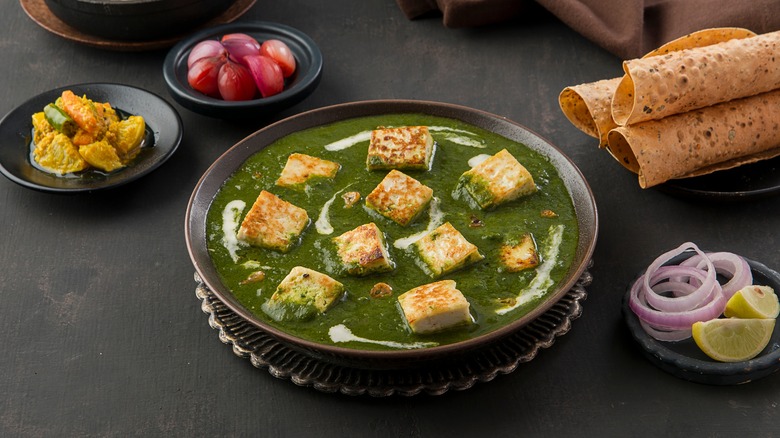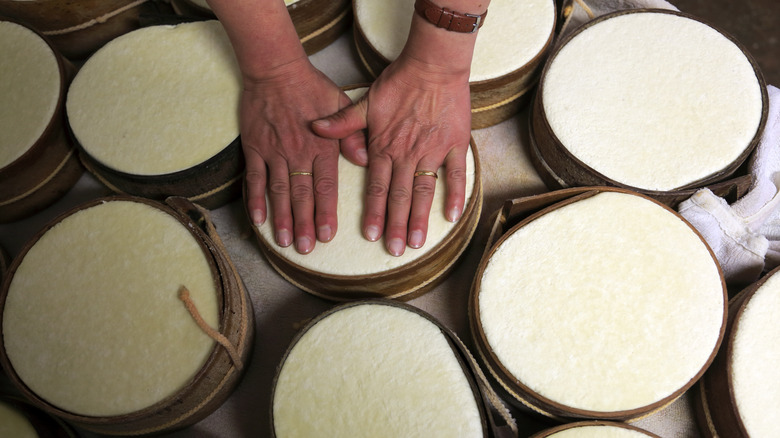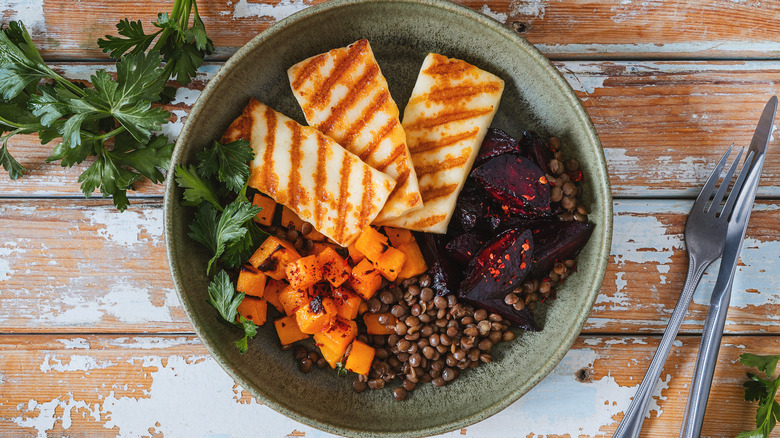Is There A Difference Between Paneer And Halloumi Cheese?
First, let's get the similarities between halloumi and paneer out of the way. Both cheese are fresh and slightly squeaky to the bite, and neither melts when heated, meaning they can both hold their shape even when grilled or fried. That makes them less than ideal as traditional pizza toppings, but opens up a world of other culinary possibilities.
Hailing from the Mediterranean island of Cyprus, halloumi is often found today in American Greek restaurants. For the appetizer known as saganaki, it's sometimes flambeed to cries of "Opa!," a tradition that evidently originated in Chicago's Greektown neighborhood. Paneer, meanwhile, is a mainstay on many Indian restaurant menus. You'll encounter it in dishes like saag paneer, where cubes of the cheese bob in a luscious, bright-green puree of spiced greens.
What differentiates the two cheeses, beyond the fact that they originate from different culinary traditions? They're the respective results of two distinct cheesemaking techniques. Paneer, like other fresh cheeses, relies on acid to coagulate. The acid causes the proteins within it to tighten during the cheesemaking process, making them less apt to separate — aka melt — when the cheese is heated later on. halloumi, on the other hand, doesn't require an acid. It uses rennet, the coagulating agent behind a lot of your cheesy faves, but undergoes the added step of being heated after its curds form, which tightens its protein networks. To understand all this better, let's dig into the science behind the cheesemaking process.
How milk becomes cheese
To transform milk into cheese, the first step is adding a starter culture and heating the milk, which encourages bacterial growth and begins the process of coagulation. Next, cheesemakers usually add a coagulating agent like rennet, which causes the curds to separate from the whey. After that, the cheese can be processed accordingly: stretched into mozzarella, aged into parmesan, and so on. Fresh cheese curds are also, of course, nothing to sneeze at.
When rennet is added to milk while making cheeses like mozzarella and parmesan, it acts on a protein called casein — the key element here. In milk, casein floats around in chains known as micelles, in which the protein molecules are held together with a calcium glue. When rennet is introduced, it changes how the micelles interact with one another, causing the milk to coagulate.
Some cheeses, however, don't rely on rennet to coagulate. Another, less common technique is to introduce an acid like lemon juice or vinegar. The category of acid-set cheeses includes chèvre, ricotta, and, yes — paneer, which can be made from either cow's or buffalo's milk. The acid dissolves the calcium that acts as the glue in the protein chains and blocks the negative electrical charge that would otherwise keep the protein molecules from bumping into one another — meaning they can get really close together. Lacking that calcium, the resulting cheese isn't very elastic. Additionally, because of the tightness of the protein molecules, it also doesn't melt very well.
What makes halloumi different than paneer
Made from a mixture of sheep's, goat's, and sometimes cow's milk, halloumi has a protected designation of origin from the European Commission, meaning that it can only be produced on the island of Cyprus according to a set procedure. What is that procedure, then — and how does it differ from the method behind other non-melting cheeses, like paneer?
Halloumi, unlike paneer, isn't an acid-set cheese — it relies on rennet to coagulate. However, halloumi undergoes an added step in the cheesemaking process that helps account for its melt-resistance: While other cheeses are heated just once, during the initial coagulating process, halloumi undergoes a second heating, in which it's boiled in whey. The second heating kills some acid-producing bacteria that could weaken the structure of the halloumi and strengthens the networks of proteins within the cheese. For these reasons, it's less apt to melt when in the presence of heat again — like a battle-tested warrior, it's been through the flame and come out stronger on the other side. Opa!


